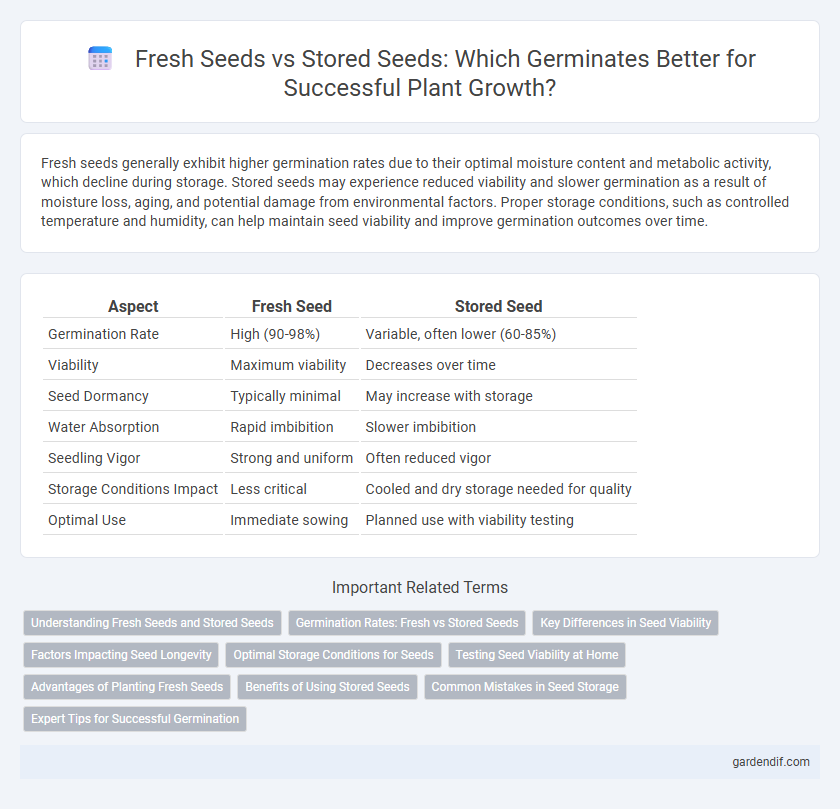
Fresh Seed vs Stored Seed Illustration
Fresh seeds generally exhibit higher germination rates due to their optimal moisture content and metabolic activity, which decline during storage. Stored seeds may experience reduced viability and slower germination as a result of moisture loss, aging, and potential damage from environmental factors. Proper storage conditions, such as controlled temperature and humidity, can help maintain seed viability and improve germination outcomes over time.
Table of Comparison
| Aspect | Fresh Seed | Stored Seed |
|---|---|---|
| Germination Rate | High (90-98%) | Variable, often lower (60-85%) |
| Viability | Maximum viability | Decreases over time |
| Seed Dormancy | Typically minimal | May increase with storage |
| Water Absorption | Rapid imbibition | Slower imbibition |
| Seedling Vigor | Strong and uniform | Often reduced vigor |
| Storage Conditions Impact | Less critical | Cooled and dry storage needed for quality |
| Optimal Use | Immediate sowing | Planned use with viability testing |
Understanding Fresh Seeds and Stored Seeds
Fresh seeds typically exhibit higher germination rates due to their optimal moisture content and metabolic activity at the time of harvesting. Stored seeds undergo physiological and biochemical changes, such as moisture loss and enzyme degradation, which can reduce their viability over time. Proper storage conditions, including controlled temperature and humidity, are essential to maintaining the germination potential of stored seeds.
Germination Rates: Fresh vs Stored Seeds
Fresh seeds typically exhibit higher germination rates due to their optimal moisture content and metabolic activity. Stored seeds may experience reduced viability over time as moisture loss and enzymatic degradation impair germination potential. Maintaining proper storage conditions, such as low humidity and cool temperatures, can help preserve seed viability and improve germination success in stored seeds.
Key Differences in Seed Viability
Fresh seeds typically exhibit higher viability rates due to intact moisture content and active enzymes essential for germination. Stored seeds often experience a decline in viability over time caused by moisture loss, metabolic degradation, and potential fungal contamination. Monitoring storage conditions like temperature and humidity is crucial to preserving seed viability during extended storage periods.
Factors Impacting Seed Longevity
Fresh seeds exhibit higher germination rates due to optimal moisture content and metabolic activity, whereas stored seeds often experience a decline in viability influenced by factors such as temperature, humidity, and oxygen exposure. Seed longevity is primarily affected by storage conditions; low temperature and controlled humidity significantly prolong seed life by slowing metabolic degradation and inhibiting fungal growth. Genetic makeup and seed coat integrity also play critical roles in determining how well seeds withstand storage and maintain germinative potential over time.
Optimal Storage Conditions for Seeds
Optimal storage conditions for seeds require low humidity levels below 8% and temperatures between -18degC and 5degC to maintain seed viability over time. Fresh seeds generally demonstrate higher germination rates, but proper storage in moisture-proof containers and controlled environments can preserve stored seeds' germination potential. Seed longevity is enhanced by reducing metabolic activity through cold, dry storage, preventing fungal growth and seed deterioration.
Testing Seed Viability at Home
Fresh seeds typically exhibit higher germination rates compared to stored seeds due to retained moisture and metabolic activity. To test seed viability at home, perform a simple germination test by placing seeds on a damp paper towel, sealing them in a plastic bag, and keeping them in a warm environment for 5-10 days. Observing the percentage of seeds that sprout during this period indicates the germination potential of both fresh and stored seeds.
Advantages of Planting Fresh Seeds
Planting fresh seeds enhances germination rates by ensuring higher moisture content and viability compared to stored seeds, which often lose vitality over time. Fresh seeds contain active enzymes and intact cellular structures that promote rapid and uniform sprouting. Leveraging fresh seeds minimizes dormancy issues and boosts seedling vigor, resulting in healthier crop establishment.
Benefits of Using Stored Seeds
Stored seeds offer enhanced control over germination timing, enabling cultivation to align with optimal environmental conditions for seedlings. Their stabilized moisture content and reduced metabolic activity during storage extend viability, ensuring more consistent and higher germination rates compared to fresh seeds. Utilizing stored seeds also facilitates quality assessment and seed treatment processes, improving overall crop establishment and uniformity.
Common Mistakes in Seed Storage
Fresh seeds maintain higher moisture content and viability, promoting robust germination, while stored seeds often face reduced vigor due to improper storage conditions. Common mistakes in seed storage include exposure to fluctuating temperatures, high humidity, and inadequate packaging, which accelerate seed deterioration and fungal growth. Properly drying seeds to optimal moisture levels and storing them in airtight, cool environments significantly extend seed longevity and germination rates.
Expert Tips for Successful Germination
For successful germination, experts recommend using fresh seeds as they retain higher viability and vigor compared to stored seeds, which may experience reduced germination rates over time due to moisture loss and aging. Proper storage conditions, including low humidity and stable, cool temperatures around 4-10degC, can help extend seed viability and improve sprouting success for seeds kept long-term. Seed priming techniques, such as soaking stored seeds in water or growth-promoting solutions, can enhance germination speed and uniformity, especially when working with older seed batches.
Fresh Seed vs Stored Seed Infographic

 gardendif.com
gardendif.com